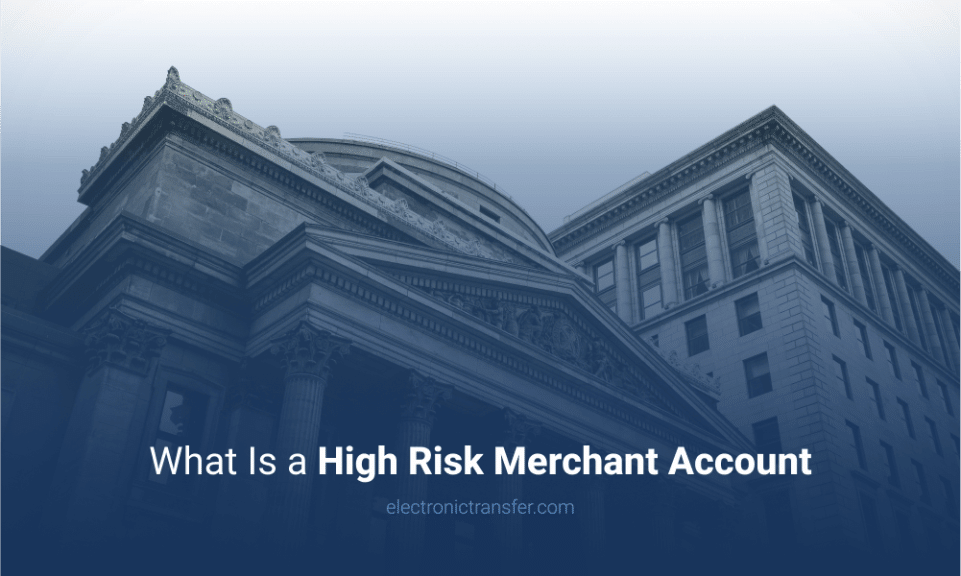What Is a High Risk Merchant Account?
Running a business isn’t easy, but it gets even trickier when you’re labeled “high-risk”. Most merchant service providers would rather avoid these businesses due to increased potential for fraud, chargebacks, and other financial liabilities. As a result, high risk merchants are left with few processing options, limiting their ability to facilitate sales and grow their operations.
Navigating the high risk industries space is no simple task for business owners but don’t fret we’re here to help. In this article, we’ll be explaining the core aspects of high risk merchant accounts and how to obtain one. Let’s start from the beginning.

What Is a High Risk Business?
The term “high risk business” is used by financial institutions to refer to companies that pose an elevated level of potential financial risk or liability. While it carries a negative connotation, it doesn’t necessarily mean the company itself is problematic.
This label applies due to the type of industry, products/services offered, sales methods, or customer base. Often, the policies used by banks and traditional processors simply haven’t evolved to accommodate more modern business models and industries.
Why Is Risk Important for Banks?
When a business gets approved for a merchant account, the acquiring bank or payment processor is taking on significant financial risk with each customer transaction they process.
With every credit/debit card charge, the bank/processor is essentially extending a short-term, unsecured micro-loan to the merchant for the full transaction amount. They front this money to the merchant with the assumption that:
- The merchant will fulfill the order and deliver the product/service as promised.
- The customer will not dispute or initiate a chargeback for the transaction.
However, if the merchant fails to deliver or the customer raises a chargeback dispute, the bank is now liable for that financial loss.
Given this, it’s paramount for financial institutions to assess the level of risk a merchant represents before approving them. A history of excessive chargebacks, fraud, financial instability, or a high-risk business model means the bank is more likely to lose money by extending that merchant credit.
What Makes a Business High Risk?
There are several potential factors that can result in a business being classified as “high risk”:
- Industry type. Highly regulated sectors like adult entertainment, CBD/cannabis, firearms, and gambling often get labeled as such due to compliance and reputation concerns.
- Business model. Companies that offer products/services with future delivery such as ticket sales, travel bookings, and subscription boxes face increased chargeback liabilities, making them high risk.
- Credit history. A less-than-stellar credit profile or track record can be a red flag. Banks rely heavily on creditworthiness as an indicator of a merchant’s financial viability and integrity.
- Products/services. Innovative business models in emerging industries like eCommerce, cryptocurrency, online services and the like frequently get saddled with high risk classifications.
Can You Avoid Being Labeled High Risk?
While the label may be unavoidable it doesn’t mean your business is in trouble.
With the right high risk merchant account solution in place, you can effectively secure your business from excessive risk exposure while continuing to process customer transactions.

What Is a High Risk Merchant Account?
A high risk merchant account allows businesses in the risky category the ability to accept debit and credit cards in payment for goods and services. As with everything, it comes with its advantages and disadvantages.
Advantages:
- Higher chargeback thresholds. High risk merchant accounts allow for higher monthly chargeback limits.
- Advanced fraud detection. High risk providers equip merchants with sophisticated fraud prevention tools and services to proactively identify and prevent fraudulent transactions from occurring.
- Regulatory compliance resources. For heavily regulated sectors, the service providers offer industry-specific compliance guidance to ensure merchants operate within legal requirements.
- Support. Rather than offering generic customer service, merchants receive personalized account management and expert one-on-one support from representatives familiar with their unique business challenges.
Disadvantages:
- Higher transaction fees. Providers charge higher transaction processing fees to compensate for the greater financial risk.
- Longer approval times. Payment service providers often have a longer underwriting process to assess and mitigate potential liabilities arising from the increased risk exposure.
- Reserve accounts. Merchants may be required to fund a reserve account, where a portion of the transaction revenue is held to cover potential losses or chargebacks. This can cause tight cash flows or low profit margins.
High Risk Merchant Account Fees
As a high risk business owner, you can and will face fixed fees as well as variable ones depending on your risk level.
Fixed Fees
- Refund fees. These are the costs for processing refunds on returned items.
- Security fees. They cover fraud prevention and security tools. They are usually fixed as well.
- Termination fees. Canceling contracts often incur penalties, or cancellation charges.
- PCI compliance fees. Since PCI compliance is mandatory for all merchants, many providers charge a standard fee.
Other Fees
- Transaction rates. These fees are typically charged to high-risk merchants to offset the increased risk.
- Chargeback fees. This is the amount a financial institution charges when a customer disputes a transaction with a merchant or there has been an error in service.
- Monthly fees. These are fees that are charged monthly and can vary on the type of services provided by the financial institution.
- Rolling reserve requirements. This is used by merchant account providers as a way to safeguard against chargebacks.
How to Get a High Risk Merchant Account
While high-risk businesses may face additional scrutiny, it’s actually a standard process, and payment providers can help guide you through the steps required to obtain a suitable merchant account that meets your needs.
- The Pre-qualification Step. First off, you’ll need to fill out an initial form with your personal information and details about your business.
- Consultation. Next, a representative will contact you to discuss your specific business needs and requirements.
- The Application. After the consultation, you’ll have to complete and submit the formal application along with any required supporting documents.
- The Underwriting Process. Your application and documents will then be reviewed by the underwriting team at the acquiring bank, who will assess your business’s risk level.
- Approval/Decline. Based on the underwriter’s assessment, your application for a high-risk merchant account will either be approved or declined.
- Reserve Agreement. Lastly, if approved, you may be required to sign a reserve agreement, which stipulates that a portion of your funds will be held in reserve to cover potential losses or chargebacks.
Is It Possible to Have a High Risk Merchant Account Instantly Approved?
Getting high risk merchant account instant approval is quite a challenge because service providers often require thorough risk assessments. Nevertheless, certain companies may present speedy services that can grant approval within a few days, and in some instances, even as swiftly as within 24 hours.
The key is to do your research well and to evaluate different providers since each one can offer a range of features, fees, and timelines.
Tips to Finding the Best High Risk Merchant Account Provider
- Research both the provider’s website and online reputation thoroughly.
- Reach out to multiple providers and ask about their application process, approval criteria, and the timeframes.
- Check the Terms and Conditions carefully. Take note of the processing and chargeback fees, chargeback thresholds, any restrictions, excluded industries, and excluded payment types.

How to Improve Your Chances of Being Approved?
After you’ve chosen the service provider for your business, you need to prepare for the approval process. You can increase your chances by following these tips:
- Research and understand the requirements and criteria required by your provider.
- Be prepared and transparent about your credit history. Providers can and will check your credit history.
- Have all the necessary documentation ready, including detailed financial statements and a business plan.
- Don’t forget to add a convincing cover letter explaining why your business is a good risk.
Wrap Up
If you’re ready to set up a high risk merchant account, providers such as Electronic Transfer Inc. have detailed and personal solutions that will help you obtain the payment processing services you need to accept credit cards and other payment methods from customers.
Start now by giving us a call – we’d be happy to help!


